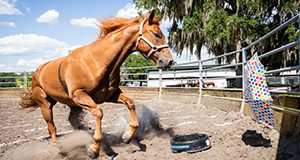This 3-page document provides an overview of anhidrosis in horses, including symptoms and management tips. Written by Laura Patterson-Rosa, Martha F. Mallicote, Robert J. MacKay, and Samantha A. Brooks, and published by the UF/IFAS Department of Animal Sciences, October 2020.
https://edis.ifas.ufl.edu/an362
Tag: Horse Health
Caring for the Older Horse: Common Problems and Solutions (AN253/AN253)
Horses often live into their late 20s and early 30s. But as the horse ages, its needs change, and additional care may be required to keep it as healthy as possible. This 5-page fact sheet addresses changes in the aging horse’s body that impact its requirements, along with possible ways to meet these requirements and solutions to problems that may occur. It was written by Edward L. Johnson, Kylee Jo Duberstein and Mark Shuffitt, and published by the UF Department of Animal Sciences, October 2010.
http://edis.ifas.ufl.edu/an253
VM177/VM139 Colic in Horses
VM-177, a 4-page fact sheet by Amanda M. House, discusses this disease symptom which is the number one cause of death in horses, what it is and what things cause it, gastric ulcers, treatment and prevention. Includes references. Published by the UF College of Veterinary Medicine, Department of Large Animal Clinical Sciences, March 2009.
http://edis.ifas.ufl.edu/VM139
VM170/VM132 Developing a Vaccination and Deworming Program for the Adult Horse
VM-170, a 4-page fact sheet by Amanda M. House, provides horse owners with guidelines to follow in developing an individualized health maintenance program with the veterinarian. It provides an overview of basic vaccination guidelines and diseases and provides guidelines for prevention and control of parasites. Includes references. Published by the UF College of Veterinary Medicine’s Department of Large Animal Clinical Sciences, May 2008.
http://edis.ifas.ufl.edu/VM132
